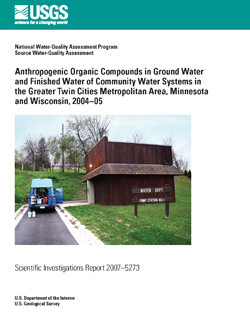Publications - Scientific Investigations Report 2007–5273
National Water-Quality Assessment Program
Source Water-Quality Assessment
By Lan H. Tornes, James R. Stark, Christopher J. Hoard, and Erik A. Smith

As part of the U.S. Geological Survey’s National Water-Quality Assessment (NAWQA) Program, two Source Water-Quality Assessments (SWQAs) were conducted during 2004–05 in unconfined parts of the glacial aquifer system and in unconfined parts of the Prairie du Chien-Jordan aquifer in the Greater Twin Cities metropolitan area of Minnesota and Wisconsin. SWQAs are two-phased sampling activities in the NAWQA Program. The first phase evaluated the occurrence of 265 (258 are included in this report) anthropogenic organic compounds (AOCs) through monitoring source water in 30 of the largest-producing community water system wells completed in the aquifers underlying the Greater Twin Cities metropolitan area. The AOCs included volatile organic compounds (VOCs), pesticides, and other AOCs. During the second phase of the study, 15 of the original community water system wells, those with the greatest number of AOC detections, were resampled along with associated finished water.
Results from the first phase of sampling indicated that 40 AOCs were detected, and 83 percent of the samples had at least one detected AOC. Concentrations of AOCs detected in the source water generally were low (defined in this report as concentrations less than 1.0 microgram per liter). Human-health benchmarks for these compounds (Maximum Contaminant Levels for regulated compounds or Health-Based Screening Levels for unregulated compounds, when they existed) typically were not exceeded. Fifteen VOCs were detected in the source-water samples. However, concentrations were low. Seventeen pesticide compounds were detected generally at concentrations less than concentrations for VOCs. Most of the pesticide compounds detected were triazine- or alachlor-parent compounds or their breakdown products. Eight other AOCs were detected in the source-water samples but generally at low concentrations.
Results from the second phase of sampling indicated a total of 13 and 12 VOCs were detected in source-water and in finished-water samples, respectively. Most of the VOCs, except for those associated with disinfection by-products, were detected more frequently in source-water samples than in finished- water samples. Concentrations of most VOCs detected in either source water or finished water were less than human-health benchmarks. Twenty-one pesticide compounds were detected in either source water or finished water. Concentrations of detected pesticides in source-water and finished-water samples were low. The most frequently detected compounds in both the source and finished water were triazine-parent pesticides or their breakdown products and breakdown products of alachlor and metolachlor. In general, pesticides, if detected in source water, also were detected in the corresponding finished water. Concentrations of pesticides detected were less than human-health benchmarks in both source and finished water. A total of nine other AOCs were detected in the source-water or finished-water samples, and about the same number of compounds was detected in each of the sample groups in either source water or finished water. Detected concentrations of other AOCs were low.
Water-quality results from source-water samples were compared to characterize differences between aquifers. VOC and other AOC detections were more frequent in water from the Prairie du Chien-Jordan aquifer compared to the glacial aquifer. Pesticides, however, were detected more frequently in the glacial aquifer. On the basis of study results, the hydrogeologic setting, land use, and aquifer productivity are important in explaining the occurrence of AOCs in community water system wells. Results of this study indicate that monitoring for pesticides in source water generally indicates the potential occurrence of pesticides in finished water but that this is not necessarily true of VOCs. Additional monitoring is needed to better understand the occurrence of other AOCs in source and finished waters.
Tornes, L.H., Stark, J.R., Hoard, C.J., and Smith, E.A., 2007, Anthropogenic organic compounds in ground water and finished water of community water systems in the Greater Twin Cities metropolitan area, Minnesota and Wisconsin, 2004–05: U.S. Geological Survey Scientific Investigations Report 2007–5273, 42 p.
For more information about USGS activities in Minnesota, visit the USGS Minnesota Water Science Center home page.
This report is available online in Portable Document Format (PDF). If you do not have the Adobe Reader, it is available for free download from Adobe Systems Incorporated.
Document Accessibility: Adobe Systems Incorporated has information about PDFs and the visually impaired. This information provides tools to help make PDF files accessible. These tools convert Adobe PDF documents into HTML or ASCII text, which then can be read by a number of common screen-reading programs that synthesize text as audible speech. In addition, an accessible version of Adobe Reader 8.0 for Windows (English only), which contains support for screen readers, is available. These tools and the accessible reader may be obtained free from Adobe at Adobe Access.